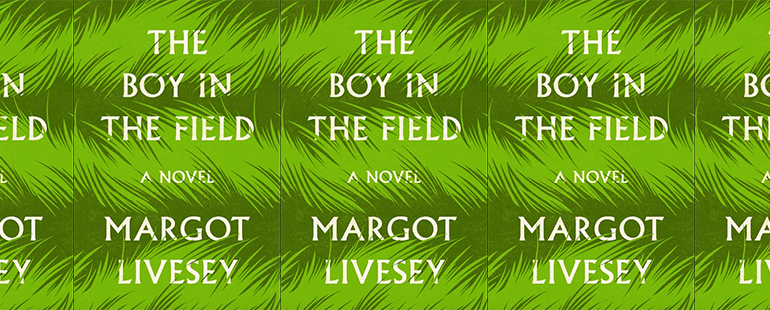“Life is about change—whether we like it or not”: An Interview with Margot Livesey

Former Ploughshares Fiction Editor Margot Livesey’s ninth novel, The Boy in the Field, out today, is a tightly constructed, compelling story that begins with a discovery: “Here is what happened one Monday in the month of September, in the last year of the last century,” it opens. “Matthew, Zoe, and Duncan Lang were on their way home from school.” The three siblings stumble upon the body of a young man, injured but still alive. This harrowing moment rings out in each of the siblings’ lives in irrevocable ways—Matthew tries to find the young man’s assailant; Zoe begins a relationship with a graduate student in an attempt to find a sort of home outside her own; and Duncan, adopted at birth, goes on a quest to find his biological mother.
Like any good book, obsession is at the heart of this novel. Throughout the narrative, Livesey fluidly alternates between short chapters from each of the siblings’ perspectives, each section advancing—and deepening—the obsessions of the respective characters. Matthew, an avid reader of crime novels, becomes more engaged in his search, which leads him to the victim’s brother and complex truths about what might have happened. The middle child, Zoe, learns an unsettling secret of her father’s, begins to question the sturdiness of her own family and begins to seek attention elsewhere. And Duncan, a talented painter and the only adopted sibling, takes in a black Labrador named Lily, who becomes a trusty companion as he searches for his mother. Livesey’s chapters read like short bursts, each one producing subtle shifts in the fault lines of this particular middle-class family. “Lily made things better,” writes Livesey from Duncan’s perspective, “but even she could not prevent his family members from traveling toward their separate destinations.”
Obsession, loss of innocence, grief, forgiveness, belonging. Readers of Livesey’s impressive oeuvre will recognize these recurring themes; each one of her novels animates different variations on these experiences, with the setting often leaping back and forth across the Atlantic. Born in the Scottish Highlands, Livesey has divided much of her adult life between the United Kingdom and Cambridge, Massachusetts, where she lives with her painter husband. During her youth, she was raised on the grounds of a private boys’ school, where her father was a teacher and her mother was a nurse. At age two, Livesey lost her mother, and then, at age twenty-two, her father. Eleven years later, in 1986, she published her first story collection, Learning by Heart. Her debut novel, Homework (1990), followed. Over the past twenty years, she has published eight more novels. All the while, Livesey has taught at many institutions, literary conferences, and elsewhere; during recent years, she has been a professor of fiction at the Iowa Writer’s Workshop. As a result, it’s not uncommon to see writers express their debt to Livesey—on Twitter and in book acknowledgments—and all that she taught them.
Like many people, I heard about Margot before I read her novels. My sister, Ami, studied with her in the low-residency program Warren Wilson and had told me more than once about her generosity of spirit, astute comments, and empathetic guidance as a teacher and a mentor. Soon after, Eva Moves the Furniture—which chronicles the life of the title character and her two mysterious ghost-like companions after Eva loses her mother at childbirth—was published on September 11th, 2001. I picked up a copy at my favorite bookstore that fall and was immediately captivated by the exquisite lyrical prose and how Margot managed to animate the porous worlds of the living and the dead with such economy, originality, and beauty. Several years later, I got a chance to meet her myself when she traveled to Austin to teach and then participate in the Texas Book Festival. We had coffee and talked about books we’d recently read, current projects, and the writing life. On one afternoon, we went on a search for the perfect pair of red cowboy boots.
In 2017, I was working on an early draft of a novel set in Belfast, Northern Ireland, during World War II. I asked Margot if she might be willing to read the manuscript; as a writer from the British Isles, I thought she could provide insights and criticisms, particularly with details and dialogue specific to the region. She said yes and a few weeks later, she sent along an editorial letter. Like my sister, I experienced Margot’s distinct brand of generosity, kindness, and keen perceptions as both a writer and a mentor. She helped me to address “small matters of language” while also pointing out larger issues. Much of her feedback was framed as questions, ultimately leaving the decisions—and the considerations—up to me. At the end of the note, Margot addressed it all by describing my next revision as “one more pass through the typewriter.”
It’s not surprising that Tin House Books collected a series of Margot’s craft-related essays, titled The Hidden Machinery: Essays on Writing, in 2017. In this insightful book, readers are given a front-row seat to the “machinery” of Margot’s sharp mind—what makes her tick as a writer, a reader, and a teacher. Taken altogether, the collection provides an instructive window into the lifelong pursuit of being a fiction writer. In the title essay, “The Hidden Machinery: Writing the Life, Shaping the Novel,” Margot advises: “Try to figure out what interests you at the deepest level but do not expose the secret parts of yourself to unkind scrutiny. What are you drawn to? What do you avoid? Admit your own mediocrity and believe in the optimism of revision.”
Margot’s attention to craft and revision is certainly evident in The Boy in the Field, from its seamless kaleidoscopic narrative to the artful suspense that propels the story along. Similar to Eva Moves the Furniture, the compressed story is elegant and effortless, speaking to the mastery of Livesey’s prose and skill. In both of these coming-of-age stories, the inner landscapes of her characters are shaped—and contoured—by losses and obsessions, large and small. I recently spoke with Livesey about her inspiration for the work and the many layers within.
S. Kirk Walsh: Where did the idea of this novel start for you?
Margot Livesey: I had the idea of the three siblings finding a boy in a field for some time. It was a story from a friend. “Friend” is too strong—someone I had gone to high school with and hadn’t seen in many decades. When I asked him about his life, he said he was planning to become a doctor, but one day he came home from school and found the body of a woman at the bottom of his garden. This was in a tiny, tiny village where no one locked their doors. She had been murdered by her boyfriend. Those few seconds—maybe less than a minute—changed my school friend’s life.
Then, something happened in my own life that was striking: since I was twenty-two when my father died, I had believed myself to have no living relatives. But a former student was doing research for me on Ancestry.com; she discovered that I had cousins in Australia. In 2018, I flew to Brisbane to meet them. I kept looking at my cousins, especially the older ones, and thinking, Okay, we share six percent of DNA, does that mean we have a connection? Does it mean that we like the same books? Do we both hate kiwi fruit? I was very fascinated by what I would feel, being in the presence of relatives. I was already writing The Boy in the Field but at that point Duncan’s quest hadn’t really come into focus for me.
SKW: Did you always know that you were going to rotate the perspectives between the three siblings?
ML: You know, you can’t always remember how you got to certain decisions. Originally I had thought of using a structure of more conventional chapters but that didn’t allow me to go quickly enough between the characters. I wanted the tension and the suspense of jumping from one point of view to another. I wanted a more flexible form. I didn’t really think about alternating the siblings. I just kept thinking, What is the next thing in the bigger story?
SKW: One aspect of the overall impact of the novel is that this family looks one way at the start of the novel and by the time we get to the end of the story, the family is entirely different. What were you hoping to reveal about the Lang family?
ML: Katherine Mansfield said, I think in one of her letters, that every member of a family is striving for their own life. They want to be a part of this organism, the family; at the same time, they want to be their own person. I think of The Boy in the Field as being in part about the loss of innocence. It’s as if the boy falls from the sky and each of the three siblings understands in different ways that there is evil in the world, that bad things happen. But families can be resilient. Life is about change—whether we like it or not—and we can learn to accommodate change.
SKW: What was it like writing Lily the dog in the novel?
ML: I saw Lily as a crucial character. I don’t have a dog now, but I grew up with dogs, and the dogs were always very important to me. I talked to them. I think many people talk to animals. I certainly hope so. I wanted to introduce another member into the family who helps to mediate and hold things together in this rather bumpy time. Somehow Lily manages to make everyone just a little more patient.
SKW: Is there a writer who you think writes animals well—and whom you used for inspiration?
ML: I always loved what William Maxwell does in So Long, See You Tomorrow when the reader gets the dog’s point of view. It’s not the same as Lily—it comes quite late in the novel—but it’s a wonderful moment. Years ago, I visited a private school in New York to meet with a number of classes. The youngest children I met with were ten years old. They had read some of my stories. One girl said, “I just don’t understand why the animals in your stories don’t talk.” I thought that was such a great question. In so many children’s books, animals do talk—and then, at a certain point, the animals shut up. I thought, Do they have to?
SKW: How did you decide on the setting of a small town outside of Oxford?
ML: Having written Mercury [2016], which was set outside Boston, I was very excited to return to the British Isles. I would have liked to have gone back to Scotland, but I felt a softer landscape was needed, one where places were closer together; where you could easily get from one town to the next. And I’ve always loved the city of Oxford with its many layers of history and its many students, and the possibility of bringing a stranger into this landscape.
SKW: Did you do much research for The Boy in the Field?
ML: I did do a certain amount. It was interesting to do research for a novel set in 1999 because in some ways it was harder than doing research for a novel set longer ago. I was relying on people who were alive, and most of them didn’t remember much. I would say, “What was the library like before it was remodeled?” And they wouldn’t be able to remember. When I went to the police station in Oxford, only one person could remember what it had been like before it was refurbished. I found myself having to give up on a certain kind of accuracy—“this is just what the police station is like”—because even the policemen working there didn’t know. [Laughs] Most of the policemen couldn’t remember what it was like before they had mobile phones. It was as if the mobile phone had erased their memories.
SKW: In the acknowledgments of the novel, you mention how a retrospective of the works of the Italian painter Giorgio Morandi at the Metropolitan Museum in 2008 inspired aspects of the novel and of Duncan’s character. As is referred to in the novel, Morandi painted the same bottles again and again. It seems like that method could be applied to fiction writing, too.
ML: I wanted one of the siblings to be an artist but I felt that to have a young writer might be boring and possibly pretentious. And I was interested in how including a painter could help the novel by allowing someone to look at the world very closely, and have surprising thoughts about color or light or an image.
When I went to that exhibition of Morandi’s, I was struck by how the paintings might be seen as repetitive, but I didn’t find them repetitive. I found them beautiful. It reminded me of what we do a lot as writers—which is go back to things, in my case, over and over and over. Sometimes making tiny changes, looking for something that is almost ineffable that has something to do with vision and rhythm and how the sentences make up a paragraph.
SKW: Your husband, Eric Garnick, is a painter. Did his work somehow inform parts of this novel?
ML: Watching Eric work has definitely informed how I think about painting—and how I thought about Morandi and Duncan. Eric works in oils, and some of his paintings have taken years. He usually works on eight or ten paintings simultaneously—as he waits for one to dry, he turns to another. There is something about the patience of that process. His paintings, like my novels, are made over time—both the relationship to time and the time in which we experience art. I think of most of the novels that I love as having many layers. We understand more as we reread them.
SKW: Is there a particular novel of yours that you feel like this new book is in conversation with?
ML: Eva Moves the Furniture. I’ve noticed in my work that I go back and forth between more hard-edged, tightly plotted narratives and narratives that are appealing to a different range of feelings. I would say Criminals and Mercury, for instance, are more hard-edged. Eva Moves the Furniture and The Flight of Gemma Hardy and The Boy in the Field are governed by softer impulses even though all three are tightly plotted and many bad things happen to the characters.


